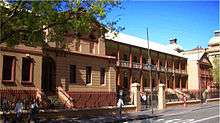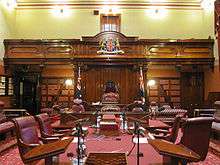Parliament House, Sydney

Parliament House in Sydney is a complex of buildings housing the Parliament of New South Wales, a state of Australia. It is located on the east side of Macquarie Street in Sydney, the state capital. The facade consists of a two storey Georgian building, the oldest public building in the City of Sydney, flanked by two Neo-gothic additions containing the parliamentary chambers. These buildings are linked to a 1970s 12-storey block at the rear, facing onto the Domain.
Unlike the parliamentary buildings of Australia's other capital cities, Sydney's Parliament House is not grand in its architectural appearance, but rather restrained and unexceptional.
Layout


The main entrances are contained in a two-storey building with a colonnaded front verandah. On the ground floor, there are two entrance halls. Between these halls is the Greenway Room, which is used for small committee meetings and events. The upstairs rooms are used by Hansard.[1] To the north of this building is the chamber of the Legislative Assembly, the lower house. The colour scheme of the chamber is green, representing the colours in the United Kingdom House of Commons. At one end of the room is the speaker's chair, and in front of this is a table holding the mace. Government members sit in the two rows of seating to the speaker's right, and opposition members to the left. There are galleries for the press behind the speaker, Hansard to the speaker's left, guests of the speaker opposite the speaker and the public above the speaker's gallery and to the speaker's right.[2]
At the opposite end of the entrance building is the Legislative Council chamber. Here, the colour scheme is red, representing the House of Lords. This chamber contains a vice-regal chair, for use by the Monarch in Australia or her representative, the governor, and the chair of the president of the council. Both chairs are made from red cedar, the vice-regal chair in 1856 and the president's chair in 1886. The table in front of the chairs was also made in 1856 from red cedar. The wall behind the two chairs is covered by bookshelves holding the Hansard records. The chamber is also decorated with seven busts, four depicting early presidents of the council in ceremonial dress and three of other prominent former members in Roman togas. As in the lower house, government members sit on the president's right and opposition members on the left.[3] Behind the entrance building is the Jubilee Room, used for committee meetings and public functions. In this area, which is open to the public, there is also the Fountain Court, an exhibition venue containing a fountain by Robert Woodward. Beneath the Fountain Court is a 175-seat theatrette and above it a roof garden sometimes used for functions. Together with a small post office, these 1970s features form a "square doughnut"-shaped building linking the streetfront buildings with a 12 storey block at the rear. This block, with views over the Domain contains offices for members and other staff and meetings rooms, as well as dining facilities, a fitness area and car parking and service areas. The building has a power co-generation unit that serves Sydney Hospital and the State Library of New South Wales as well as Parliament House.[4]
History



The oldest part of Parliament House was built first as the north wing of Governor Macquarie's "Rum Hospital". Macquarie Street was created and land in the Domain was assigned by Governor Macquarie in 1810. As there was no funding from the British government, a contract to build the hospital was arranged involving convict labour and a monopoly on rum imports. The building of three two storey colonnaded buildings was completed in 1816 and was praised as "elegant and Commodious" but also criticised for both its design and construction by Francis Greenway.[5] Defects resulting from short cuts taken by the builders were still being discovered in the 1980s.[1]
The north wing was the Chief Surgeon's quarters, although at one point it was used as law courts. When the Legislative Council was formed in 1824, it did not have a permanent home and met in places such as the old Government House. In 1829, the Council's membership increased from five to 15 members, and it began to meet in the downstairs northern room of the Surgeon's quarters from 21 August. Only two rooms were left for the Chief Surgeon, with the remaining five rooms used as offices by the Clerk of the Executive and Legislative Councils and other government officials. From 1831 to 1836, the Clerk was also the curator of Australia's first museum, a small natural history collection which became beginning of the Australian Museum collection.[1]
The Legislative Council was increased to 36 members by the new colonial constitution in 1843. The room in the old building was no longer large enough, and so a new chamber was added to the north of the building. This chamber became the home of the new Legislative Assembly when a bicameral system was introduced in 1856. The Legislative Council was relocated to a prefabricated iron building that was assembled at the southern end of the original hospital building. The building had been manufactured in Scotland by engineering firm Robertson & Lister and originally shipped to Melbourne. It was purchased for £1,835. The cost of erecting and furnishing the building as well as the new offices was £4,475. The incomplete building was used first for the official opening of the new parliament on 22 May 1856.[3][6]
The new chamber was not without its problems. The walls, originally lined with packing boards covered with hessian and plastered, and the curved iron roof cause problems with acoustics, lighting and ventilation. The roof was replaced with slate in 1959. Other changes followed as the façade was moved 3 m closer to the street in 1892–93. Deterioration in the southern wall became apparent during the 1920s, and wooden props were added to the outside of the southern wall and inside the chamber to hold up the ceiling. The southern wall was entirely rebuilt in the 1930s.[3]
In the meantime, a dining room was constructed behind the hospital building by 1969 and the Parliamentary Library, which in 1850 had been moved to the original Legislative Council chamber, expanded and relocated back into the two remaining ground floor rooms, which were united to form the Greenway Room. The Jubilee Room was built as a reading room for the library in 1906.[1]
In 2013, a man threatened to blow up parts of the building, but was prevented from doing so by NSW police. They stormed his car and took the man into custody.[7]
Rebuilding proposals and extension
In 1964 a document titled Report and Development Plans for the Eastern Side of Macquarie Street was prepared by the New South Wales Government Architect. The plan envisaged the removal of Sydney Hospital to another location to make way for a monumental new Parliament House. The Mint, Hyde Park Barracks and the Rum Hospital's northern building (part of the current Parliament House) were to be refurbished and adapted for reuse. The proposed new Parliament House was planned with an extensive civic square with a massive fountain to terminate the view along Martin Place. However, change of government from Labor to Liberal in 1965 slowed the pace of major public works.[8]

In 1970 plans for a new Parliament House were spearheaded by the Parliamentary Librarian, Dr Russell Cope. An Advisory Committee was established, representing both Houses and all political parties to determine accommodation needs for the Parliament. At the time much of Parliament House was substandard and a possible firetrap. The majority of members shared rooms. Even the Leader of the Opposition occupied an inadequate space over a hot and noisy boiler room.[8]
In 1972, the brief and a development plan, prepared by the Government Architect, were tabled in Parliament. After a review, the Treasury recommended the deletion of the swimming pool, but Premier Robert Askin rejected this advice. Unlike the proposed demolition proposed in the 1964 scheme, the 1972 development plan required the new building to be constructed entirely within the boundary of the existing site, while leaving space for future additions to the State Library of New South Wales. Added to this restraint the work of the Parliament needed to continue through the entire construction period. To achieve this the construction was divided into a number of stages, including a temporary accommodation building on the parliamentary tennis court and bowling green.[8]
In 1975, Premier Tom Lewis asked for the inclusion of an auditorium and a media centre. The same year tenders were called for the initial works (demolition and excavation). The initial works also included the stone by stone relocation of an historic building, Richmond Villa, to Kent Street, Millers Point, Sydney. Design and construction documentation was the responsibility of the New South Wales Government Architect, while construction management was tendered to the private sector. The Hornibrook Group was the successful tenderer.[8]

In 1979, once the first stage facing the Domain was completed, the second stage was constructed to link the first stage with the existing heritage buildings facing Macquarie Street. The last stage of the rebuilding program was completed in 1985, with the interiors of the chambers of the Legislative Council and Legislative Assembly restored to their appearance in 1892. As well the old Surgeon's Quarters of the Rum Hospital, together with the former Parliamentary Library, were refurbished, in a manner consistent with the two restored chambers.
Artworks
Many art works at Parliament House were on loan from the Art Gallery of New South Wales. The rebuilding project was seen as an opportunity acquire new works and a percentage of the overall budget was set aside for their purchase. Four women received commissions for works to be hung in prominent areas of the new building. In the dining area used for State receptions hang two tapestries by Fay Bottrell. In the main lift lobby Margaret Grafton’s tapestry depicts the coat of arms of New South Wales. A series of wall hangings by Heather Dorrough are in the staff dining room, while the historically referenced depiction of Parliament House by Kitzpatrick hangs in the Fountain Court.[9]
Members, ministers rooms and staff rooms are hung with either framed prints or photographs by contemporary Australian artists. A number of works on canvas were also purchased, the most notable being a portrait of Patrick White by Brett Whiteley.[9]
Alleged hauntings
In August 2009, it was reported that there have been reports of hauntings by a few ghosts of former staff of the building and patients of what was the old hospital.[10]
References
- 1 2 3 4 The "Rum Hospital" and Parliament House, Parliament House History Bulletin 9, Parliamentary Education and Community Relations and Parliamentary Archives 8/97: 7,000.
- ↑ "The Legislative Assembly Chamber". Legislative Council. Parliament of New South Wales. Retrieved 17 August 2006.
- 1 2 3 "The Chamber". Legislative Council. Parliament of New South Wales. Archived from the original on 15 July 2006. Retrieved 17 August 2006.
- ↑ "How Parliament Works". Resources. Parliament of New South Wales. Retrieved 17 August 2006.
- ↑ "Rum Hospital 1811 - 1854". The Mint. Historic Houses Trust. Archived from the original on 27 April 2006. Retrieved 17 August 2006.
- ↑ Parliament of New South Wales: History Bulletin 1 "The Heritage Buildings of Parliament House". Sydney: Parliament of New South Wales. 2011.
- ↑ "Police drag taxi dispute protestor Abdula Ganiji from car after NSW Parliament House is placed in lockdown over bomb threat". Retrieved 28 September 2016.
- 1 2 3 4 Australia's First Parliament, published by the Parliament of New South Wales, 1987
- 1 2 Australia's First Parliament, published by the Parliament of New South Wales, 1987
- ↑ "Ghosts roaming NSW Parliament". The Daily Telegraph. 18 August 2009.
External links
| Wikimedia Commons has media related to Parliament House, Sydney. |
Coordinates: 33°52′02″S 151°12′45″E / 33.867324°S 151.212586°E